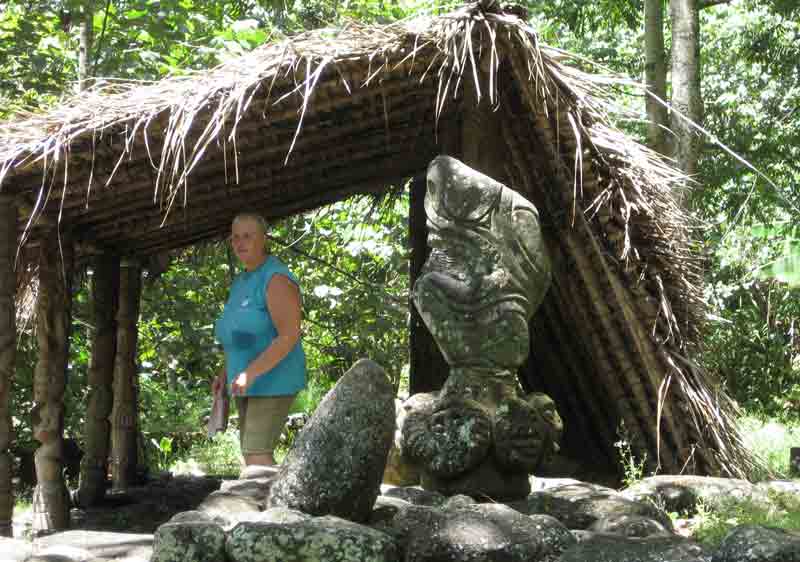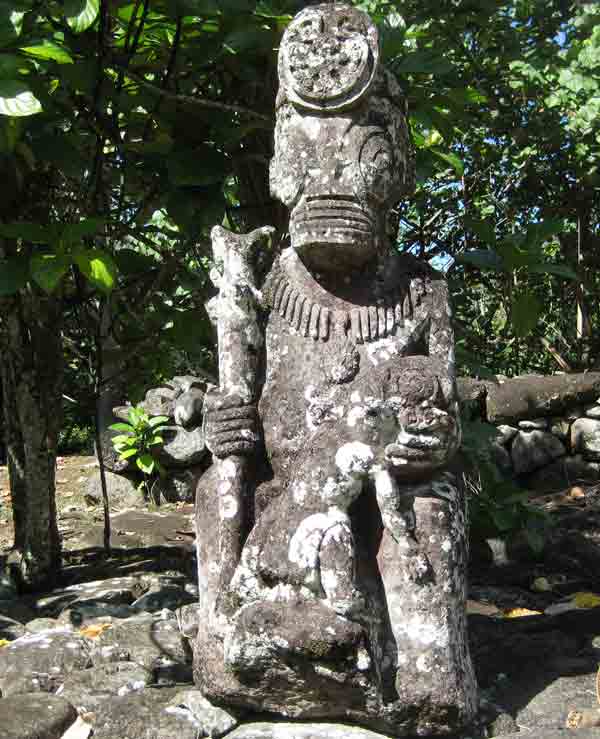Nuku Hiva

ANGEL
David & Valerie Allen
Wed 5 May 2010 00:03
| 08:55.09 S 140:05.99 W Friday, April 16,2010 On Wednesday we completed our 3,136.4 NM passage from the Galapagos to Nuku Hiva in the Marquesas of French Polynesia. Hooray!!!! This was the longest passage we have undertaken and the longest leg of our circumnavigation. I had not been looking forward to reaching landfall after such a wonderful passage. However, when the winds died completely and we had to motor for the last 24 hours of the passage, we were both more than ready to set the hook and stand on terra firma. It was quite a thrill to catch sight of the little island of Ua Huka after seeing nothing but sea for so long! French Polynesia covers an area of about five million square miles and is divided into several island groupings. The northernmost islands are the Marquesas. These are majestcally beautiful volcanic islands. The scenery is breathtaking. However, since there are no encircling protective reefs, we were advised not to swim or even get in the water in order to remove the forest of 3-5" gooseneck barnacles which had accrued above the waterline on passage. With no barrier reefs, apparently the Tiger Sharks were free to enter the bays and anchored boats are great attractions for them. We removed the fauna as much as possible while trying to hang upside down out of the dinghy which was highly active because of the huge swells in Taiohae Bay. We had also been warned of the vicious mosquitos if it was wet weather and of the nono flies if it was dry. The latter of these creatures apparently inflict pinprick sized bites, which, if scratched will blister and become infected, required medication. The prospect of enjoying ourselves in this environment was really quite dim. HOWEVER, as soon as we entered the bay, between the Sentinel Rocks, we discovered a very pleasant reality. These photos show you our first sight of Taiohae Bay, Nuku Hiva.   This is one of the loveliest and friendliest spots we have ever visited. And it is such a treat to be able to communicate in French instead of Spanish! I never realized how easy it was to speak without having to think out every word! We celebrated our arrival with dinner at the Pearl Lodge Resort, along with Gillian and John from SPIRIT OF NINA. The food was absolutely delicious, the company great and the view over the harbour stunning. It was great to arrive! After a walking tour of the village, we booked a 4x4 tour of the island. What a wonderful way to explore the far-flung areas and to learn about the history of this wonderful island! We had at first wondered why the people in the village all seemed to own 4x4s. We soon discovered why! There are excellent paved roads throughout most of the island, but even these were very steep and the non-paved roads were inaccessible without such vehicles. Our guide, Jocelyne, was fantastic- knowledgeable, accomodating and she served us the best mangoes ever for our afternoon snack! We started and ended the tour with views overlooking our anchorage at Taiohae Bay.  Another stop was at Controller's Bay. This was the site of the Survivor: Marquesas television series. It is quite spectacular. However, the company which produced it did no favours for the local people. They stipulated that absolutely no one was allowed to view the areas where they were filming (all over the island). As a result, tourism was basically non-existent on the island for two months (and tourism is the backbone of the economy). The television people said the island would be rewarded with increased American visitors after the programme was aired and the islanders would enjoy watching the programme. No increased tourism resulted and the programme was never aired in French Polynesia. A visting tourist gave Jocelyne copies of some of the episodes. However, they were on videotape in a different format to the local one. So no one has yet seen the series!  The view is spectacular! A highlight of the tour was a visit to Taipivai, the village on which Herman Melville based his novel, Typee. The story itself is based on a Marquesan legend and this book will be one of our purchases when we reach Canada! It is an enchanting spot. We were particularly fond of the local church. It is absolutely charming, set amid thousands of coconut palms (the planting of which was encouraged by the early missionaries to start up the copra industry in the region).  The Marquesan Cross has been placed above the entrance doors. It is an adaptation of the Christian crucifix and figures prominently in local tapa cloths and in tattoos. The entire church was crafted by the local congregants and is meticulously maintained.  The altar was carved from a single piece of local wood. The drum is typical of the region.  This Madonna is one of the most tender and lifelike ones we have ever seen. Baby Jesus is carrying a breadfruit, a plant essential to existence in the islands. There was also a statue of Joseph teaching Jesus the carpentry trade. He is carrying local tools.  In the garden in front of the church, there is an upended tattoo stone. This would have been on its side and the little wells would have contained inks. Tattooing was and still is very popular. Traditionally the holes were pierced with a kind of comb. The tattoos we saw are much more tasteful than we see in North America and very attractive. The archeological sites we visited were outstanding. Until the twentieth century human sacrifice was practised in these areas. Sacred sites are located near magnificent Banyan trees. Stone platforms (like raised terraces) were constructed for rituals. Wooden and stone carved tikis warned people that they were entering a sacred area. Sacrifices were made at times of great peril or need (such as in the case of an extended drought). The men sacrificed were usually enemy captives. The victims were drugged and stored in small pits near the marae (platforms). Only the priests and/or the chiefs (male or female) actually took part in the ritual and eating of the victims flesh (usually eyes, heart, brain as these were important for transferring life and wisdom). The leftovers and thew sacrificial instruments were then put into a rubbish tip at the roots of the banyan tree until the bones were cleaned. Then they were burned and buried.  Standing on the marae at the foot of the banyan tree.  the sacred "rubbish tip" Throughout the forest at the marae and at the larger area where sports and festivals were held there were many petroglyphs. This one represents fish and turtles- very important for fertility and longevity.  At the festival area, this is the shelter in which the chief's extended family would sleep. The tiki in front gives warning that this is a special site.   This tiki is a fertlity god, created for an inter-island festival a few years ago. After all this scrambling through the ruins we were ready for lunch at a restaurant in picturesque Anaho, at Chez Yvonne.  The local brew was in great demand! The tablecloth is made of tapa cloth, woven from local trees. On the way back to Taiohae Bay, we stopped to admire this beautiful rock formation. Somewhere up there is a statue of Mary created by a priest and maintained by a local family to this day.  What a fabulous day!!!!!! |